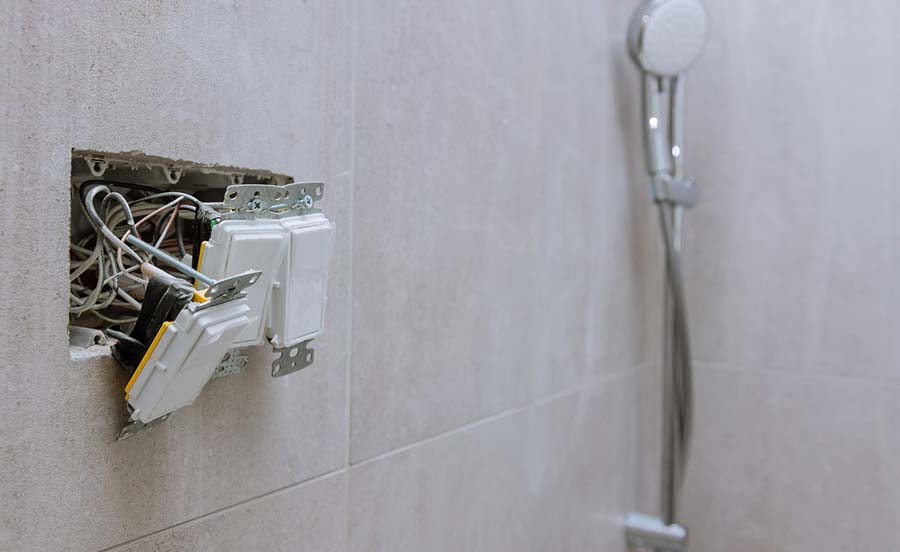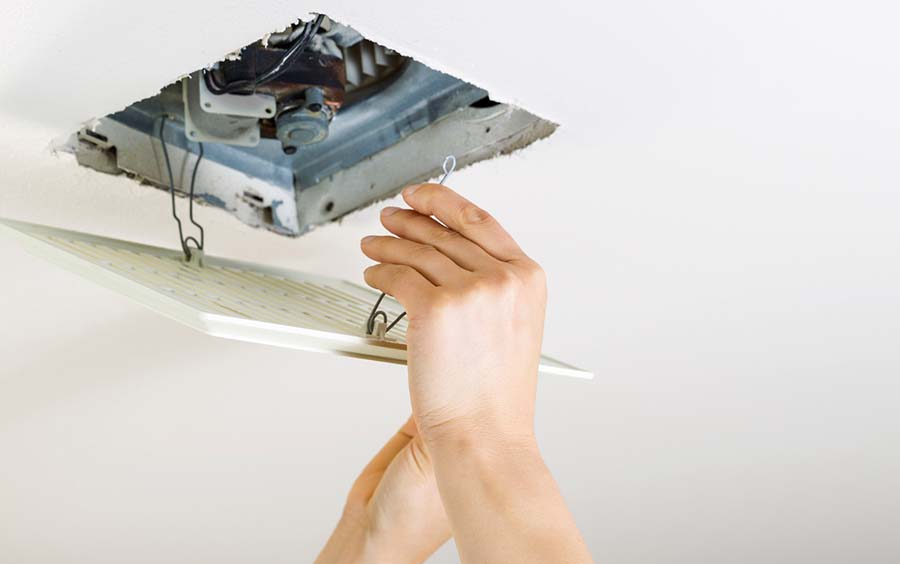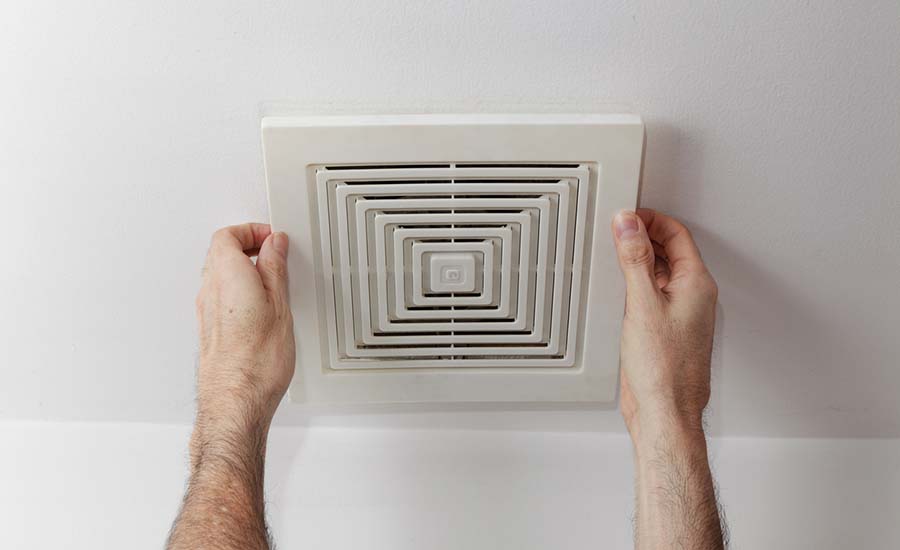
Bathroom fans with light fixtures are common these days. If you have this arrangement, you may want to wire the bathroom fan and the light and operate them from the same switch. So how do you wire a bathroom fan to a light switch?
Wiring a bathroom fan to a light switch is very straightforward. If the bathroom fan and light are separate fixtures, you’ll need a short wire to connect the two. Turn the power off, connect the white wires, connect the black wires, ensure it’s grounded, turn the power back on, and you’re good to go.
But there’s more to know about bathroom fans and light switches. Here is some helpful information to use when wiring your bathroom fan to a light switch.
Can You Wire a Bathroom Fan and Light On the Same Switch?
It is possible to arrange for the bathroom fan and the light to run on the same switch. You may have two switches but only need one switch to run the two. This process is not only possible but easy to achieve.
It is not a bad idea to connect the bathroom fan and light in your home on the same switch. It is safe to operate both at the same time. Running the fan in the bathroom is one of the best ways to prevent mold from growing in your bathroom.
Mold in the bathroom is a result of the condensation of hot water. It can reduce the bulb’s life expectancy and destroy light fixtures. However, running your fan prevents water from condensing and sucks the moisture out of the room to help prevent mold.
For this reason, most homeowners opt to install a fan in the bathroom. Running your fan and the light on the same switch can help you avoid having to change light bulbs destroyed by molds and prevent molds from growing in your bathroom, leading to various health issues.
High humidity levels in a bathroom may cause other issues such as deterioration of wooden and metal fixtures, which may be costly to repair. A fan helps to keep the humidity levels low to prevent such occurrences. Wiring a bathroom fan to a light switch also allows you to conserve electricity.
For the fan to be effective, it is essential to ensure it’s centered correctly in your bathroom. You may choose to wire the fan and the bathroom light switches separately. You may also decide to use the same switch so that they both come on when you are using the bathroom.
Also, you may want to run both the fan and the lights on the same switch even though you already have two separate switches. Before connecting the two on the same switch, here are various things to note:
The Mains Electric Supply
Before starting the wiring process, you must understand that the mains electric supply comprises three fundamental wiring systems: live, earth, and neutral.
The live system is the black or red wire which carries current in the system. The neutral wire is white and takes the electric current back to the electric box. The ground wire is the green wire (or bare copper) connected to the ground bar inside the electric box.
Using the Right Wire
You must choose the correct wire that is compatible with the power outage of the appliances. Wires that use copper or aluminum are good conductors of electricity.
You should also note that a wire may be either solid or stranded. A solid wire may not be a good option during wiring as it cannot handle higher frequencies. Stranded wires are more effective in wiring because they are flexible.
Use Insulated Wires
When conducting wiring, always make sure that the wires used are insulated. Insulated wires are safe to use and help withstand fires and other electric risks. Examples of insulated wires include:
- Heat Resistant Wire (HR)
- Fire Resistant Wire (FR)
- Low Smoke Wires (FRLS)
Turn Off the Switch
Before starting this process, a word of caution is to turn the switches that control both the light and the fan off. After turning off the switches, it is always good to use a voltage checker to ensure no current flowing through the circuits before starting the process.
You’ll Need to Make Pigtails
A pigtail is a collection of wires that have a short yarn length. Pigtails are common when conducting electrical work. This collection of wires will allow you to connect the cables to one terminal.
The key to a good connection is twisting the wires together clockwise. This way, the wires can make the link more effective and tighter when screwing them.
Converting Two Switches to One Switch
You should know that wiring a bathroom fan to a light switch involves converting two switches in the same box to one switch.
You should be aware of the wires that supply power to each switch. If you have no clue, you can test the wires by connecting the two black wires from both switches to the ground using a voltage tester. The live wires will indicate a reading on your tester.
How to Wire a Bathroom Fan to an Existing Light Switch
Start with shutting off power. Use wire connectors and wire the cable to the housing box. Once done, you can now wire the cable to the fan, and after checking all connections, you can restore the power.
Before you begin the process of wiring a bathroom fan to a light switch, there are various tools you’ll need. These include:
- A screwdriver
- Wire strippers/cutters
- Voltage tester
- Flashlight
- Wire connectors
- Terminal block
- Wire strippers
- Pliers
- Tape measure
- Cable ties
- Level
- Ladder
- Electrical cable
- Utility knife
- Fish tape
Below is a detailed procedure to follow when wiring a bathroom fan to an existing bathroom light:
1. Shut Off Power
Turn off the circuit breaker that controls the bathroom where you wish to work. Once you have done this, it is essential to flip the light switch on to ensure that the circuit is off. Alternatively, you may use a voltage checker or a circuit checker to confirm that the circuit is off.
2. Remove the Light Globe
Using a ladder, carefully remove the light globe from its fixture. You can do this by unscrewing the holding screws. Once you have done this, set aside the light bulb. Unscrew the screws that hold the cover plate in place and gently pull it down so that you can be able to see the wires attached behind it.
You must confirm the circuit is off by checking if there are flashing lights or any beeps when using a voltage or electricity tester.
3. Remove the Wire Connectors
Turn the twisted wire connectors counter-clockwise to separate them from the housing box’s paired white and black wires. Using your pair of pliers, you can untwist the wires and straighten them out. Also, confirm that you have unscrewed the ground wire from the ground screw.
4. Run a Cable to the Housing Box
Run a cable from your bathroom fan to the housing box located in the ceiling. If you do it right, you will be able to pull the electrical cable to the housing box in an area above the fan using fish tape.
5. Wire the Cable to Your Bathroom Fan
Connect the fan by matching the black and white cables from the new wire to meet the fan’s wires. Make sure that you screw the neutral bare copper wire to the ground screw of the fan.
6. Use the Wire Stripper to Remove the Outer Sheath
Using your ladder, move to the ceiling’s lighthouse box to strip the light’s end cable outer sheath. You can use a wire stripper or a utility knife. Strip about 6 inches of the sheath on white and black wires.
7. Connect the Correct Wires
Attach the stripped and straightened ends of the light and switch’s black cables to the fan’s corresponding wires. Twist the ends of the wires in a clockwise direction using a pair of pliers. Make sure that the wires physically connect before adding another wire. Repeat this process for the white and neutral wires.
8. Restore Power
When you have connected the wires, fold them neatly, placing them into the housing box. Take time to reinstall both the cover plate and the light bulb on the ceiling. Turn on the power again. If you made the connection correctly, the fan and the light switch both come on simultaneously.
Safety Precautions for Wiring a Bathroom Fan to a Light Switch

During the installation of this wiring system, there is some risk involved. It is essential to observe safety precautions such as wearing protective clothing and having the right tools before beginning the wiring process. Here are five safety precautions that are crucial to follow:
1. Make Sure the Power is Off
One of the first safety precautions is making sure that the power is off before starting any electrical work. If possible, use a tester to ensure that there is no electricity flowing through the circuit.
2. Wear Protective Gear
Covering your body is crucial when dealing with electricity. You want to avoid sparks or debris from falling into your eyes. You can also wear protective clothing such as a long shirt, pants, gloves, and soled shoes.
3. Always Test the Connection
Purchase a voltage tester to check that the wire connections are not passing off electricity before you begin working on them.
4. Use the Right Tools
Many dangerous incidents are likely to occur during wiring if you neglect using the right tools for the job. When wiring a bathroom fan and a light switch, you must use the proper tools to improve the efficiency of work done.
The essential tools needed during wiring are a voltage tester, wire cutters, continuity tester, tape, and nose pliers.
5. Revisit Your Wiring Connection
Before you conclude that the work is complete, recheck your work. When doing this kind of wiring, the last thing you need is a loose connection that is likely to cause fires.
Check that your connections are secure and connected with the correct wires. Once you have done this, you can turn on the electricity and check the efficacy of your wiring. If you are uncertain about this procedure, talk to a trusted electrician to do the wiring.
Common Errors Made When Wiring a Bathroom Fan to a Light Switch

Especially if you don’t have experience with home repairs, there are many mistakes you can make when connecting a bathroom fan to a light switch. There should be no loose wire connections, no exposed wires, faulty wire connections, or loose circuit breaker connections. Let’s take a closer look at some of these errors below:
Loose Wire Connection at Switch and Outlet
A wire connection at the switch and outlet will likely become loose during wiring installations; thus, this should be one of the first areas to inspect if you suspect wire connection problems.
Buzzing or cracking sounds from the fan or flickering lights could indicate a loose wire at the switch. First, turn off the power, so there is no electricity reaching the switch or the light to fix the problem.
Once the power is off, you can remove the cover plate and examine the screw terminals using a
In some cases, you may find that wire connections have push-in-fittings which fail in most cases. If you find the connection made using push-in fittings, carefully remove them and reconnect the wires.
In addition, it is also essential that you check the box to make sure that the wire nuts connect securely. One of the most common problems is a loose connector.
Wire Connections Done Using Electrical Tape
A standard error is connecting wires using electrical tape rather than a wire nut. You can solve this problem by removing the electrical tape connecting the wires after turning off the power. You can then join the wires using a wire nut or any approved connector.
If you find that the ends of the wires are damaged, strip off the insulation ends to about 4 inches and make a wire nut connection.
Two or More Wires Connected Under One Screw Terminal
This is one of the most common mistakes and is a clear sign of amateur work, thus posing a fire risk. It is wrong to wedge two wires under one single screw.
You can fix this error by turning the power off and cutting about 6 inches of pigtail wire of the same color as the wires. Strip off about 4 inches of the insulation ends of the pigtail wires and connect the end of the wires using a wire nut. You can then attach the ends of the pigtail wire to the terminal.
Exposed Wires
If your connection does not work, the wire connection likely has either too much or little exposed wire. It is essential to ensure that the stripped copper wire is not exposed and wrapped entirely around the terminal.
If bare copper wire extends from the screw, there will likely be problems with your connection. Wrap the wires in a clockwise direction around the terminals. They are prone to loosen if tied anti-clockwise.
Loose Connections Made on the Circuit Breaker Terminals
This is one of the least common problems when wiring a fan to a light switch. Loose connections in the circuit breaker are rare, however not impossible to happen. If this happens, you will notice that lights are flickering or problems on the fixtures along with your connection.
When making circuit breakers, it is essential to strip off enough bare wire to ensure that the connection is secure. Make sure that there is no insulating material under the connection slot.
A professional electrician should fix such a problem. This kind of problem needs an experienced and knowledgeable professional.
Faulty or Loose Neutral Wire Connections
During this kind of wiring, the other common problem is when you mount the neutral wire incorrectly to the primary service panel. The circuit will behave similarly to that of a faulty wire.
An electrician can fix this problem by ensuring that this wire grips the neutral bar correctly.
The above are some of the problems you will likely encounter while wiring a bathroom fan to a light switch. You will be able to fix most of these problems. However, it is always good to seek professional help to avoid further damage and risks.
Conclusion
Wiring a bathroom fan to a light switch is one of the most straightforward arrangements you can make in your home, provided you have the know-how and the essential tools for the procedure. Before you begin the process, you must understand the basics of wiring systems.
Ensure that the power is off when wiring a circuit to prevent electrical shock. It is also essential to wear protective gear to protect yourself from electrical harm. It is possible to wire a bathroom fan to a light switch; however, you may seek professional help from an electrician if you are uncertain about the process.
Sources
- How to Wire a Bathroom Fan and Light on One Switch
- 6 Common Wire Connection Problems and Their Solutions
- How to Hook Up a Bathroom Fan & Light to One Switch
- Safety Procedures to Follow During Wire Installation







